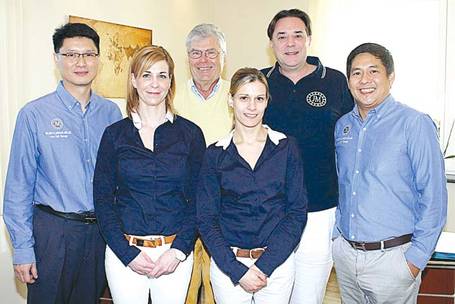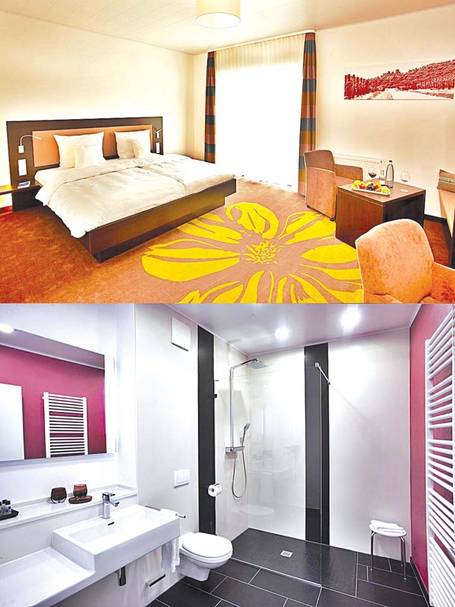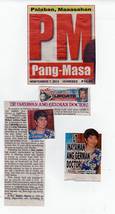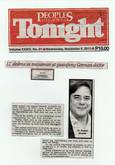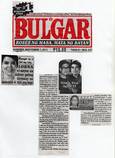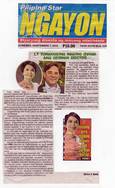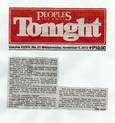Persartikelen


Live cell therapy–why it’s not about healing and performing miracles
By Alex Y. Vergara Philippine Daily Inquirer, March 23rd, 2014
 |
It’s not only about adding years to life, but adding life to years.”
This in essence sums up the philosophy behind Dr. Robert Janson-Müller’s practice as a general practitioner in Munich and as a specialist (one of a handful) in live cell therapy in Edenkoben, a picturesque, grape-producing town one hour south of Frankfurt.
A growing number of Asians, including Filipinos suffering from such ailments as diabetes, heart disease, degenerative disorders of the joints and spinal column, multiple sclerosis, mild depression, burnout, migraine and even impotence, are braving the 14-hour flight to Germany to avail themselves of the therapy pioneered in the ’30s by Swiss doctor Paul Niehans.
Live cell therapy, which is an “organ-specific” approach, involves harvesting fresh cells from sheep embryo and injecting them directly (intramuscular) on the patient’s buttocks.
Not a few parents also swear by the therapy’s beneficial effects on their children with mild autism, attention deficit and hyperactivity disorder (ADHD) and Down’s syndrome.
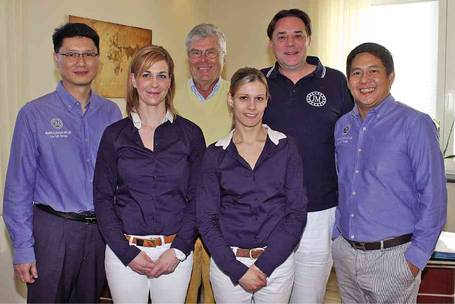 |
Better functions
During our coverage, for instance, we came across an Indonesian couple with an 11-year-old son with ADHD and mild autism. After trying all sorts of treatments to improve their son’s focus and EQ, including a daily dose of the drug Concerta, the couple learned about live cell therapy from another parent with an autistic son.
“Before live cell therapy, he was mostly limited to one-word sentences,” said the dad of his son. “And when he talked to people, he lacked eye contact. Now, I could teach him to form complete thoughts and sentences.”
The son, who’s enrolled in a regular school, also started doing better in class. The former loner “who kept to his own business” has become more friendly, empathetic and involved in group activities, said his doting father. Best of all, he has stopped taking oral medications.
“We’ve been going here every year since 2010,” he added. “We’re now on our fourth visit. According to my son’s doctor in Singapore, he needs at least five treatments.”
The treatment supposedly addresses a gene defect, especially among children with Down’s syndrome, to help enhance metabolism in the brain, which results in better cognitive functions.
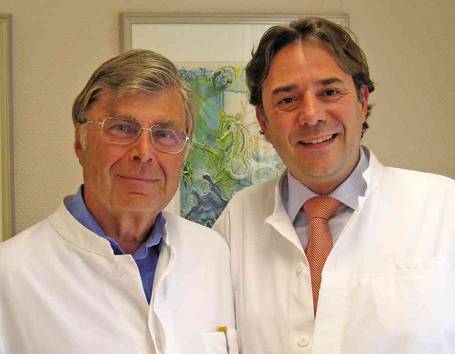 |
And then there are the usual beauty junkies who credit their youthful glow to their twice-a-year visits to Müller. Although more than 80 percent of his patients have real health problems, as much as 15 percent see him regularly to get their beauty fix.
“You can’t make anyone younger,” said Müller. “It’s not possible. Make them look and feel better, yes. ”
Looking good, he added, is more the result of a healthy body and positive disposition. A person freed from all sorts of ailments invariably becomes more energetic and younger-looking.
Not for cancer patients, pregnant women
Live cell therapy is not about healing and performing miracles. Provided the person isn’t suffering from chronic infections such appendicitis, tonsillitis, tuberculosis, Aids and even abscessed teeth, he or she is bound to benefit from the therapy’s “rejuvenating” effects.
“It’s seldom for a doctor to really heal,” he said. “Mostly you treat. I do that in both my practice here and in Munich. Healing is something that Jesus Christ did.”
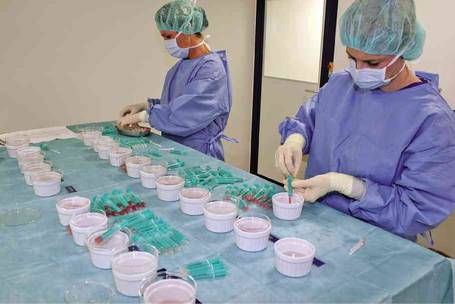 |
Since cancer runs counter to the treatment’s essence, which is to rejuvenate and activate cells, he also doesn’t accept patients afflicted with the big C.
“If I activate the cells of a person with cancer, I might end up putting more oil in the fire,” he said.
Pregnant women and those on permanent dialysis are also not ideal candidates for the therapy. Müller doesn’t want to endanger the lives of those on dialysis, since there are no nearby facilities to do the procedure.
In the case of pregnant women, injecting them with foreign cells might produce an allergic reaction that could harm both mother and unborn baby.
That’s why it’s important for patients to do a thorough medical exam, including their blood chemistry, before flying to Germany to do the treatment. Once accepted in the program, patients are also expected to disclose their entire medical history to help Müller come up with the right treatment program for them.
“It makes no sense to let someone come from the Philippines only for me to discover in the morning of the examination that he has active prostate cancer,” said Müller. “I want to know who’s coming to me. That’s why I check everything again by conducting my own blood work.”
Sheep embryo
Each sheep embryo (from 16 to 17 weeks old or five weeks shy of being born) can provide as many as 10 to 15 patients with a variety of cells from 70 different organs, including the pituitary glands and thymus (glands responsible for the regulation of certain hormones and boosting the immune systems, respectively).
It’s different, safer and a lot more effective than autologous stem cell therapies (stem cells taken from the patient) and stem cells harvested from, say, the bone marrow of supposedly younger and healthy individuals, said the doctor.
“If you do the treatment using human cells, you could also transfer genetic problems and diseases from the host to the recipient,” said Müller. “The risk is much higher. Here, the likely problem would have to jump from one species to another, which is much more unlikely.”
Niehans started doing the treatment using cow fetus. For practical and scientific reasons, the practice has evolved over the decades and now uses only the best Merino sheep (the same breed that provides materials for sweaters) sourced from a farm in the nearby town of Neustadt.
Müller also scoffed at claims by a certain competitor that it uses “black mountain sheep.” As far as he’s concerned, there’s no such thing.
“A herd of, say, 1,000 sheep is easier to handle than a herd of 1,000 cows,” he said. “Sheep are smaller, easier to handle. It’s not a big problem doing a Caesarian operation on a sheep to get the fetus, but it’s a big mess to do it on a cow.”
Contrary to their meek nature, sheep are also robust animals. Unlike, say, dogs or pigs, they’re not prone to cancers and strokes.
Also, “If you go to a Catholic Church, it’s the lamb that is sacrificed,” said Müller. “This time the animal sacrifices itself to give health to humans.”
Direct way
The approach seems almost like a direct and literal way of treating an ailment by zeroing in on the organs responsible for it. Thus, if a patient is suffering, for instance, from joint problems, Müller extracts live cells from the fetus’ joints. He then mixes them with sterile water before injecting them into the patient.
Müller downplayed fears of any allergic reaction. In fact, in all his years as a practitioner, he has yet to encounter a patient who went through an “allergic shock” after being injected with sheep cells. The worst that could happen is visible redness on the injected buttocks.
“It’s because I’m injecting only fetal tissues,” he said. “Unlike cells from mature animals, these fetal cells don’t have antennas or HLA antegens on them yet. Otherwise, there would be a fight between mother and fetus.”
Since time is important, he does everything within an hour or two after the mother sheep is slaughtered and its embryos extracted.
“I’ve been told by my father that when it comes to live cell therapy, the faster, the fresher, the better,” said Müller, referring to his dad Dr. Wolgang Janson-Müller.
After 38 years of practicing live cell therapy, the elder Müller, perhaps one of the best living proofs that the treatment works, retired to give in to his wanderlust. Active and youthful-looking at 73, the old man skis in the winter and travels around the world during summer.
After working with his dad for several years, the younger Müller, now 47, was more than happy to take over.
A typical treatment, which involves as many as nine to 25 injections depending on the patient’s needs, can set you back by 12,000 euros. Patients and their companions stay for four days and three nights at the cozy and modern Luitpold Hotel, which doubles as a hospital while also housing Müller’s clinic (see related story).
No extra charge
Regardless of the number of injections a patient receives, Müller doesn’t charge extra for additional injections, like some live cell therapy clinics reportedly do.
He doesn’t resort to a one-size-fits-all approach, either. That’s why it’s important for Müller to see the big picture as far as his patients’ health is concerned. For chronic and degenerative disorders like MS and Alzheimer’s, the treatment would have to be repeated every six months to one year.
“Each person is different down to his health needs,” he said. “That’s why every person is getting individual, tailor-made combination of cells.”
Apart from 18 years of experience in live cell therapy tucked under his belt, Müller has a virtual link to the late Niehans, the acknowledged father of live cell therapy.
His late grandfather, Dr. Philipp Janson, a pioneer of Niehans’ brand of live cell therapy in Germany, occasionally worked and regularly exchanged notes with Niehans. Janson, in turn, trained and worked with his son Wolfgang (Müller’s dad).
“We will see what my daughter is going to do,” said Müller, referring to his teenaged daughter. “She said she would like to go into medicine, but it would ultimately depend on what she really wants.”
Call Joey Santos, Dr. Robert Janson-Müller’s Philippine country representative, at 0917-8986564, 6338653; e-mail jcsantos_primemed@yahoo.com; visit www.janson-mueller.de.

Cracking the fresh cell code
Experience and expertise run in the genes of this doctor, a third-generation fresh cell therapy practitioner
by Ivy Lisa F. Mendoza, March 4, 2014
It was a pleaseant, winter morning in Edenkoben, Germany and a group of 15 people from various countries such as Indonesia, the Philippines, Italy, and Germany congregated for breakfast in a coffee shop in this quaint city. Most of these people just flew in from their respective countries, or drove in from different European cities.
But they were not there for an international conference. They were all there for their shots of fresh cell from Dr. Robert Janson-Mueller.
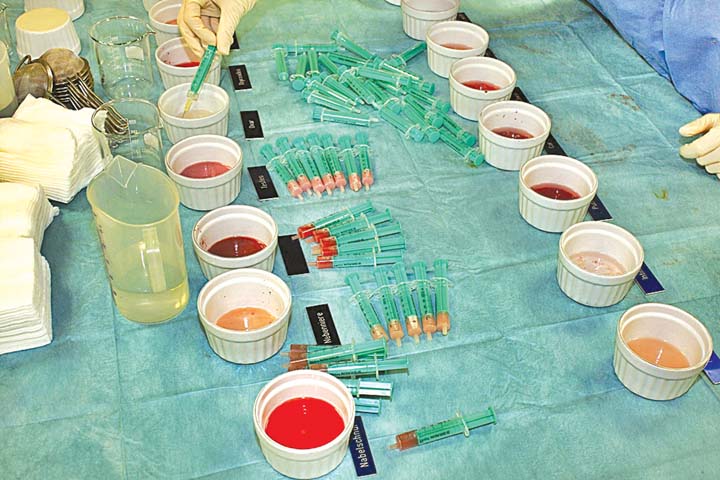 |
For the past couple of years, through his solo practice, Dr. Robert Mueller has been sharing the benefits of fresh cell therapy with people who need to seek alternative means to remedy various diseases or chronic conditions of their body, or anti-aging solutions.
Although Filipinos has heard of stem cell therapy only in recent years, thanks to celebrities and politicians who have undergone the treatment and do swear by its efficacy, fresh cell therapy has been around since the 1930s.
The Swiss doctor Prof. Paul Niehans first injected cells originating from animal organs intramuscular into patients in 1931 and is thus considered the founder of live cell therapy. Dr. Robert Mueller’s grandfather, Dr. Philipp Janson, was one of the first doctors to introduce this method in Germany in 1949. His father, Dr. Wolfgang Janson-Müeller, also extensively practiced for 35 years.
"Since the 90s, I have been able to participate in the wealth of experience that my father, who is always available for help and advice, has gladly passed on to me. I have been using this method of treatment in my own practice since 2003," says Dr. Mueller.
However, the 47-year old doctor differentiates his practice from others (there are only five known doctors who do fresh cell therapy in Germany) because his clinic tailor-fits the fresh cell injections according to the specific needs of the individual’s body. A patient thus gets from about eight to 30 injections, depending on the needs.
In this interview with Dr. Mueller, the German expert sheds more light on this therapy that is attracting more and more Filipinos as an alternative treatment. He also explains why fresh cell therapy is not a cure-all or a miracle therapy, why cells from the sheep embryo is being used, why the treatment is becoming popular in Asia, and why it is not possible, up to now, that these therapies can be done in the Philippines.
For more information on fresh cell therapy, visit the website www.janson-mueller.de or call Joey Santos at 0917898-6564 or 633-8653.
Why do you use fresh cells from sheep fetus and not human cells for your treatment?
Dr. Robert Janson-Mueller: It is an ethical problem that I would never even think of doing. It makes no sense to use human cells because the animal cell, for example, a sheep’s liver, is about 95 to 96 percent matched with a human being’s liver. If you look through a microscope, it is very, very similar. Even if you take a human liver, it will only match 98 percent even if the patients are related. Besides, if you use human cells, you can also transfer genetic problems and diseases, the risk is much higher, especially with genetic problems.
So you have never used human cells in your entire practice?
RJM: Never — and I will never do, not even my father did that.
Do you have studies that back up your practice of fresh cell therapy?
RJM: There are very little scientific studies about fresh cell treatment. My father and his colleagues did some. The first treatment was in the 1930s, before the World War 2 and in the beginning, it was Dr. Paul Niehans, the Swiss doctor who was one of the developers of cellular therapy, and my grandfather, Dr. Philip Janson, a dermatologist, who did many trials and errors. I found scientific papers by my grandfather which showed trials and errors, which disease does fresh cell therapy makes sense or not.
THE FASTER, THE FRESHER, THE BETTER
What diseases or conditions is live cell therapy perfect as a remedy?
RJM: It is perfect for degenerative disorders of the joints (arthrosis) and of the spinal column (osteochondrosis) and rheumatic complaints, neurological disorders including multiple sclerosis, paralyses after a stroke, circulatory disorders following due to disorders of the vascular system, migraine, heart diseases, respiratory organ disorders, chronic liver, and kidney diseases. It is also good for some hormonal disorders for women especially those in the menopausal stages, and also impotence or decrease in libido for men. It is good for diabetes, hypertension ,thyroid problems, and skin problems.
It is also good for premature aging and age-related manifestations of wear-and-tear, general exhaustion and lack of energy
The fresh cells that you use are tailor-made specific for specific conditions?
RJM: Yes, every individual gets a specific tailor-made combination of cells. That is why it is important to have a pre-examination. Prior to coming to me, I need to know everything. In the Philippines, our country representative Joey Santos works with some doctors who find out what I want to know about a patient, who send me the bloodworks. Then I decide if they can undergo the therapy here in Germany. Here, I redo everything, including the bloodworks. If I have doubts, I repeat the tests and then I make the judgment
So there is a literal matching of cells from sheep fetus with human cells, for instance, a patient needs liver cells so you give him more sheep liver cells, etc?
RJM: Yes, every person gets an individual combination. This is something different from other clinics who have standard program and everybody is getting a standard program. We get the cells from the sheep fetus at 5:30 p.m. and at 8 p.m., the patients get injection. Everything is produced, made, and packed for everybody in the laboratory,
I made some tests to see how long the cells live and viability of the cells, after four or five hours, but this is what I was taught by my father – the faster, the fresher, the better. This is why you will see us somehow running, and the injections are very quick.
Would it not work for example, if something is wrong with my kidney and I am injected with liver cells instead?
RJM: That is not wrong, but if I would like to stimulate your liver, I would give more liver cells, or stimulate your kidney, more kidney cells.
What about the heart, can stem cell relieve a blocked heart to avoid a bypass?
RJM: In this case I used heart cells, it will work but it is not the cure. I can keep a patient on the level where he is. I can prevent him from getting more problems very soon.
Do you accept patients undergoing dialysis?
RJM: That is not a possibility because we do not have a dialysis machine in the clinic.
How often must a patient undergo the therapy to be able to feel the effect?
RJM: To have effect, you have to repeat it. Once is not realistic. To see the result, normally I offer to do about three treatments in a row, and in between the patient can contact me and ask me questions. If there is no effect, I tell the patient that maybe it is not the right treatment for you.
NOT CANCER
Are there diseases that you refuse to treat with fresh cell therapy?
RJM: Yes, I am not treating cancer, even at its early stage. During treatment, I create something or make something grow, I rejuvenate or activate the cells. If I treat a cancer patient, I would be putting some oil in the fire, and cancer might even grow!
But how come some doctors claim that stem cell can cure cancer?
RJM: I have a different opinion and I would never treat a patient suffering from cancer. I have some patients who have had cancer, who have gone through chemotherapy, surgery, or radiation. After five years, if everything is smooth, I can maybe treat this person’s intestine, or liver or skin. But I would never touch the tissue where the cancer is.
What else will you not touch with fresh cell therapy aside from cancer?
RJM: Schizophrenia, very bad moods. I do not treat women who are pregnant, or those who have some kind of chronic infection like appendicitis,tonsilitis, gall bladder infection, those who have a fever.
What about women who are having difficulty in having children?
RJM: The question is, ‘how sterile are they?’ Thirty percent of the problem comes from the female, 30 from the male, and 40 in their matching. I always treat both. We cannot give guarantees but we have quite a lot of children where it worked, and I recommend these people to try to be treated for one and a half years, and we’ll see.
THIRD GENERATION OF EXPERTISE AND EXPERIENCE
Of course your father and grandfather have been into this field, and you said you had a choice. But why did you choose to go into this field and what is it about it that excites you?
RJM: I took over a running practice of my father after we worked together for five years. In the beginning, I took over all the patients of my dad. There are some who already had 50 to 80 treatments when I took over.
I have two jobs as a doctor, I have practice in Munich where I run a big clinic with 25 doctors, and I have my fresh cell therapy practice here in Edenkoben. My two practices are very different. But the very high success rate of my live cell therapy practice makes me happy, especially when a person suffering from some kind of disease comes back and says thank you. I will be very happy.
Are there practices of your dad that you have had improvements on?
RJM: I think if there is a new doctor, he always has new ideas . So did my father to his father, and so did I to my father. I am applying the same knowledge and procedure of producing the cells and individualizing it to the patients. But the standards of the 50s are much different from today’s.
My father did not treat any Asian patients, and this is new. Asian patients have their own needs, and own problems and own diseases. At the end of my father’s career and beginning of mine, there were also a lot of Americans. My father had many French and German patients.
What are these particular needs of Asian patients?
RJM: Hypertension, liver, diabetes, hepatitis B and C, many much more than we have here in Europe. And there is a big focus on libido, sexual functions and virility. I think I have more diabetic patients from Asia, and mostly from the Philippines because they consume a lot of sugar and rice.
To what do you attribute the popularity of fresh cell therapy these past few years in Europe and Asia?
RJM: I think what is happening in Asia now is same as what happened in Europe in the 70s and 80s. It became popular here because of celebrities who underwent it, like Pope Pius VI who was treated by Dr. Niehans, presidents, politicans. Today, Asia is opening, and the economy is also doing well.
GUARANTEEING THE SOURCE
Why sheep and not other animals?
RJM: Ethically, if you use dogs in Germany, you would be closed down. A herd of 1000 sheep is easier to handle than a herd of 1000 cows. It is also not a big problem to do caesarean procedures on a sheep.
Second, this kind of sheep has no cancers, or cancer tissues are very little. Other animals are prone to cancer, they are very robust.
There might also be a spiritual thinking into using the lamb – the lamb that sacrifices itself to give life to others.
What kind of sheep is this and what is the source of these sheep?
RJM: They are Merino sheep. It is a herd that exists and has been used for the procedure for the past 40 or 60 years. They are in some kind of quarantine to prevent them from contamination. The female row is closed for 20 generations, that means no animal from outside comes in. Every three or four years, we get a new male with certification. There are several veterinarians, including official doctors of the government who certify and see everything is okay. They are fed a 100 percent organic feeds.
What about the so-called black mountain sheep?
RJM: There is no such thing. It is a fake story. There is no such variety here.
You are in a very controversial field, and many doctors in the Philippines denounce the fresh cell therapy, or promote the autologous cell therapy, how do you deal with this?
RJM: I am doing the treatment as a third generation doctor and I can look back at a very long experience. I am not doing something that is hyped or a trend that everybody wants. I am not changing my attitude and I am in this for the long term, just like my grandfather and my father. You need very good experience to really treat patients in this way. This is a wonderful treatment in the hands of a good doctor. But in the hands of somebody who does not know what he is doing, you are causing a lot of problems and side effects.
Frozen cells are said to be brought into Manila, are they as effective?
RJM: It has an effect as well, but if you have a choice to get it fresh or frozen, even in meats or fish, which would you rather have?
The second point is the legal issue. doctors from Germany have no right to practice in any other country and work, and smuggle the cells into the country. I will neverdo that.
Do you plan to expand in other countries like in Asia to answer the demand?
RJM: We have several meetings already with the Department of Health in Manila and the only way that this would be possible is to practice legally, and I would need to get a license in the Philippines to practice there, I also need facilities. And we can only do frozen cells because we cannot produce fresh cells that fit the qualifications.

Yes, it hurts
By Alex Y. Vergara Philippine Daily Inquirer, March 23rd, 2014
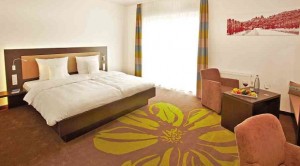 |
Having gone through my fair share of injections and all sorts of painful hospital procedures while growing up, I’ve never been afraid of needles. That is, until recently.
Can you blame me? Instead of one or two pinpricks, I’ve had to endure 10 injections given one after the other—five on each side of my butt—in the hope of finding temporary yet effective solutions to a number of health concerns.
Yes, I bit the bullet almost a month ago by agreeing to undergo live cell therapy in the hands of famed German doctor Robert Janson-Müller (see main story).
Within the comforts of my hotel room (one of 24 rooms at the fairly new Luitpold Hotel, which also doubles as Müller’s hospital and clinic), I was asked to lie flat on my stomach before Müller and his team of nurses went to work.
Having learned from experience that any medical procedure becomes more dreadful once you start staring at the needle, I never bothered to look and ask how many syringes one of the nurses had on her tray. Had I done so, I would probably have had second thoughts.
Each syringe supposedly contained sterile water combined with a cocktail of cells Müller extracted an hour or so earlier from a lamb embryo, and targeted specifically to address my needs. How painful were they?
For lack of a better description, it was like willing yourself to sample a spread of awful-tasting buffet dishes before your host. You had no choice but to swallow them.
Almost all of them were bearably painful, but certain injections were more painful than others. As Müller was halfway through the procedure, I simply bit my lip and held on to my pillow with each shot before thanking the heavens as soon as it was all over.
Organ-specific
Prior to the procedure, I spent the earlier part of the day consulting with Müller. Such one-on-one consultations would form the basis of his “organ-specific and tailor-made” treatments for me and a dozen other patients.
(Disclosure: Since each embryo normally yields enough cells for 15 people, publicist and former journalist Ivy Mendoza and I were able to avail ourselves of the treatment for free, at almost no extra cost to our hosts.)
While the rest of the patients, including a 63-year-old Filipino woman who attributed her speedy recovery from an emergency spinal operation to a previous treatment she received from Müller to manage her diabetes, rested and underwent “detoxification” and vitamin infusion the entire afternoon, the good doctor was busy several kilometers away preparing the necessary cell combinations to be injected in the evening.
A sheep farm in the nearby town of Neustadt has been providing Müller with pregnant Merino sheep for his needed embryos. After being carefully selected and quarantined from the rest of the herd, the sheep is slaughtered before its embryos are extracted and liquefied.
“We don’t save the mother sheep anymore because it makes no sense to keep her alive,” Müller explained. “I could do a Caesarean by closing her, but before you know it three weeks have passed and she’s now ready to be slaughtered for lamb chops.”
Over the years, Müller has been able to build a good relationship with the farm’s owners. In fact, the family has allowed him to build a sterile and state-of-the-art laboratory within the compound to work on his concoctions. He then drives back to the hotel in Edenkoben armed with individualized syringes ready to be injected.
Over in three minutes
My huge room may have looked like any other modern hotel room in the world, but I soon realized on day two of my four-day, three-night stay that it wasn’t.
Nurses armed with their own keys came and went to administer vitamins intravenously, check on my temperature and, minutes before the procedure, inject me with an anti-allergy shot.
It was almost surreal, especially when I emerged from the bathroom to find a team of barely recognizable masked men and women led by Müller wearing scrubs and staring back at me. This is it, I told myself.
It was a good thing they didn’t barge in while I was naked, as the place was for all intents and purposes not a hotel you could cocoon yourself in, but a hospital with postcard-pretty views minus that sickening antiseptic smell.
The actual procedure was over in less than three minutes. But not even Müller’s gentle voice continuously coaxing me to “think of your rejuvenation” was enough to soothe my frayed nerves and sore bottoms, as I was mildly trembling on and off for the next 20 minutes or so as I lay flat on my stomach.
My friends at the office could laugh about it now, but had I said a word while I was shaking involuntarily, I would have probably sounded, they teased, like the poor unborn lamb that went straight to heaven for my sake. Oh, no-oo-oo-oo!
I learned later on from Joey Santos, Müller’s business partner in the Philippines, that my reaction was more “psychological.” Each patient reacts differently during and immediately after the series of injections, he said.
When Santos first invited me several weeks earlier to fly to Germany to interview Müller, I was initially cool to the idea of trying the therapy myself. It wasn’t the number of injections that bothered me, but the likely side effects I could face later on.
What made me change my mind? The minute I learned that Ivy, a good friend of mine, was doing it in the hope of finding some relief from her nagging back problems. What have I got to lose?
Fortunately, I’ve never experienced any serious and prolonged aches and pains in my life. One of my major health issues is hidden from view and seemingly more benign.
Low blood count
Sometime in 2011, while I was hospitalized supposedly for dengue, my blood count dropped to alarmingly low levels. It was to be expected, as one of the most common manifestations of dengue is a dramatic drop in a person’s blood count, especially his platelets.
Less than a week after I was discharged, my attending physician required me to undergo another round of blood tests. The results gave her good reason to be concerned. Although my platelet count had barely managed to cross over to the safe side, my white blood count or WBC was still below average.
She immediately advised me to see a hematologist. As the blood specialist and I went through my earlier records, I discovered that my condition had already existed as early as 2008 (perhaps even earlier). I was so focused on my lipid profile that I (and so did my doctors then) failed to see other more telling aspects of my earlier blood tests.
Looking back now, I could only laugh about it because I really thought I only had a few months more to live. Well, to be technical about it, we’re all dying the minute we were born, aren’t we? Some just die ahead of others.
A spleen exam and two bone marrow biopsies later (I told you, I’m now a hardened veteran when it comes to needles), I’m still very much around and up and about despite my less-than-average WBC.
To this day, my hematologist still can’t figure out what exactly is wrong with me. If it’s any consolation, both biopsies done on me in 2012 and 2013 revealed that I’m so far cancer-free. And the best part is I don’t feel and look sick.
“It’s just your luck that your bone marrow was probably made in China and not in Japan,” my hematologist once kidded me.
No one-shot deal
During my morning-after consultation with Müller, I learned that the cocktail of sheep cells he mixed especially for me included, among others, liver cells (for optimum metabolism), spleen cells (to boost the immune system), skin cells (to help relieve me from my chronic eczema) and parts of the small intestines (again to help boost my immune and digestive systems).
For good measure, he added bits of umbilical cord (again for improved skin regeneration), heart and blood vessel cells, thymus (another immune booster) and, yes, bone marrow to help boost my low blood count.
Hopefully, I would start seeing and feeling the effects within one to four weeks, Müller said. But live cell therapy, he added, isn’t a one-shot deal, especially for people suffering from degenerative and irreversible diseases such as multiple sclerosis and Alzheimer’s, where the main goal is to keep them “on a plateau longer.” Follow-up visits every six months are thus necessary.
“Just listen inside yourself,” Müller said. “Usually, the more severe the patient’s health problems are, the more dramatic the results. You don’t have a severe health problem.”
Well, I will soon find out if my Chinese-made bone marrow has found its match in the good doctor’s German-made sheep cells.

